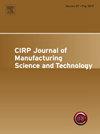Development of numerical model to investigate the process mechanics of eccentric square pin during friction stir welding
IF 5.4
2区 工程技术
Q2 ENGINEERING, MANUFACTURING
CIRP Journal of Manufacturing Science and Technology
Pub Date : 2025-05-14
DOI:10.1016/j.cirpj.2025.05.001
引用次数: 0
Abstract
The tool pin feature is a key factor for driving the weld quality and material flow characteristics during friction stir welding (FSW). A thermomechanical coupled Eulerian-Lagrangian (CEL) model is developed to simulate the influence of tool pin eccentricity (0.0, 0.1, and 0.2 mm) on the variation of mechanical properties, material flow, temperature, and forces. The Eulerian volume fraction (EVF) technique has been used for defect identification, and the model is validated with experimentally observed defects, peak temperature, and forces. Results show enhanced mechanical and thermal characteristics with increased pin eccentricity and tool tilt angle. The eccentric pin resulted in an enhanced effective pin geometry, resulting in higher swept volume, i.e., leading to improved strength and plastic deformation with a higher rotational path of the material. Widening of the stir zone is observed with an increase in pin eccentricity from 0.0 to 0.2 mm. The highest weld efficiency of 86 % is obtained for tilt and 0.2 mm pin eccentricity with a stirred zone peak temperature of 439 °C and 9.4 effective strain. The material flow is studied using tracer material to understand the extent of material flow behavior with pin eccentricity. Variation in temperature, heat flux, strain, and material velocity is studied for different angular motions of the tool pin.
建立了搅拌摩擦焊偏心方销过程力学数值模型
工具销特性是影响搅拌摩擦焊焊接质量和材料流动特性的关键因素。建立了热-机耦合欧拉-拉格朗日(CEL)模型,模拟了工具销偏心(0.0、0.1和0.2 mm)对机械性能、材料流动、温度和力变化的影响。欧拉体积分数(EVF)技术用于缺陷识别,并用实验观察到的缺陷、峰值温度和力对模型进行了验证。结果表明,随着销偏心和刀具倾斜角度的增大,机械和热特性得到增强。偏心销增强了有效销的几何形状,从而提高了扫掠体积,也就是说,提高了材料的强度和塑性变形,提高了材料的旋转路径。随着引脚偏心率从0.0 mm增加到0.2 mm,观察到搅拌区变宽。当焊缝倾角为20,销轴偏心为0.2 mm,搅拌区峰值温度为439℃,有效应变为9.4时,焊缝效率最高,为86%。利用示踪材料对材料流动进行了研究,以了解针偏心对材料流动行为的影响程度。研究了刀具销在不同角度运动下的温度、热流密度、应变和材料速度的变化。
本文章由计算机程序翻译,如有差异,请以英文原文为准。
求助全文
约1分钟内获得全文
求助全文
来源期刊

CIRP Journal of Manufacturing Science and Technology
Engineering-Industrial and Manufacturing Engineering
CiteScore
9.10
自引率
6.20%
发文量
166
审稿时长
63 days
期刊介绍:
The CIRP Journal of Manufacturing Science and Technology (CIRP-JMST) publishes fundamental papers on manufacturing processes, production equipment and automation, product design, manufacturing systems and production organisations up to the level of the production networks, including all the related technical, human and economic factors. Preference is given to contributions describing research results whose feasibility has been demonstrated either in a laboratory or in the industrial praxis. Case studies and review papers on specific issues in manufacturing science and technology are equally encouraged.
 求助内容:
求助内容: 应助结果提醒方式:
应助结果提醒方式:


